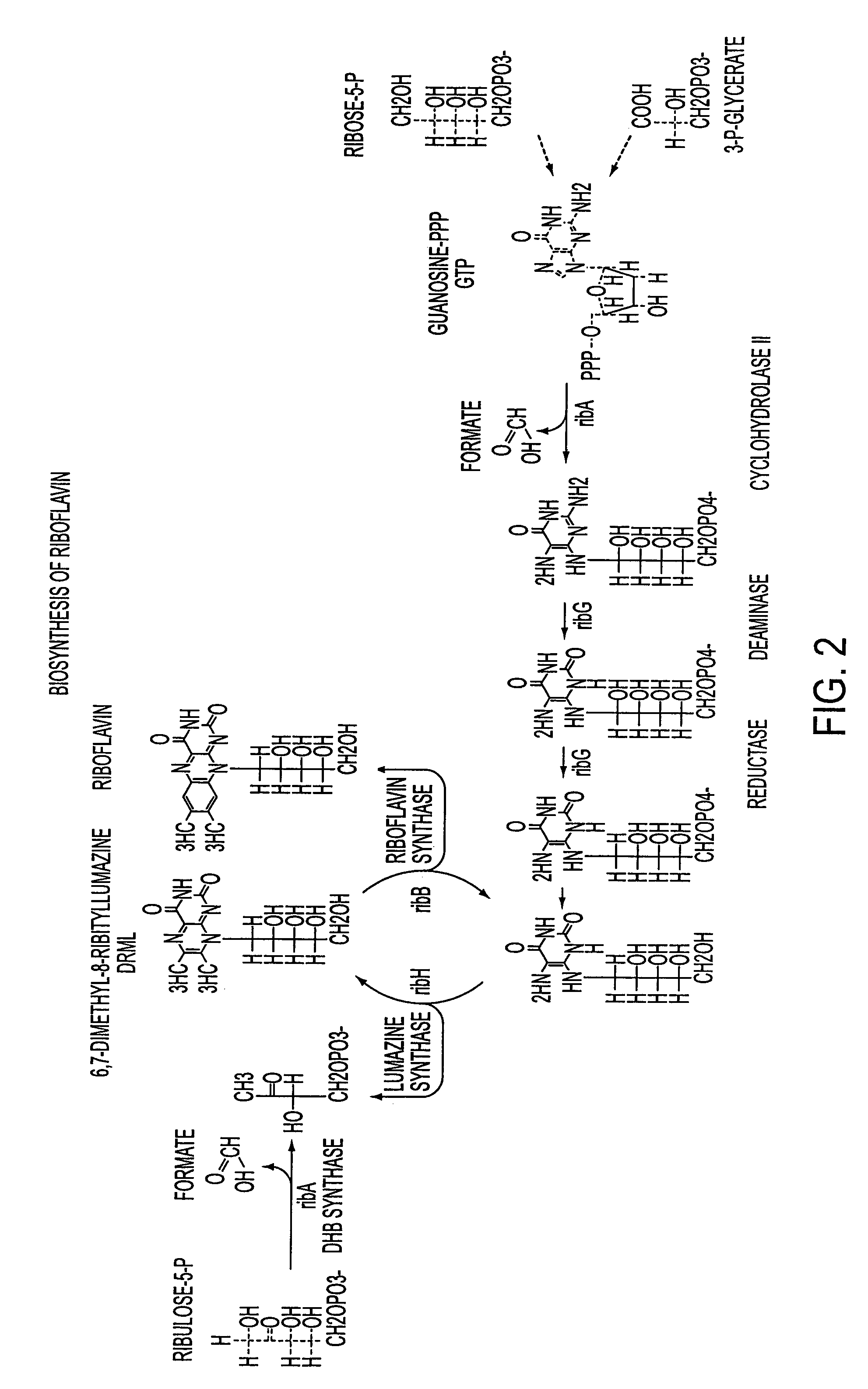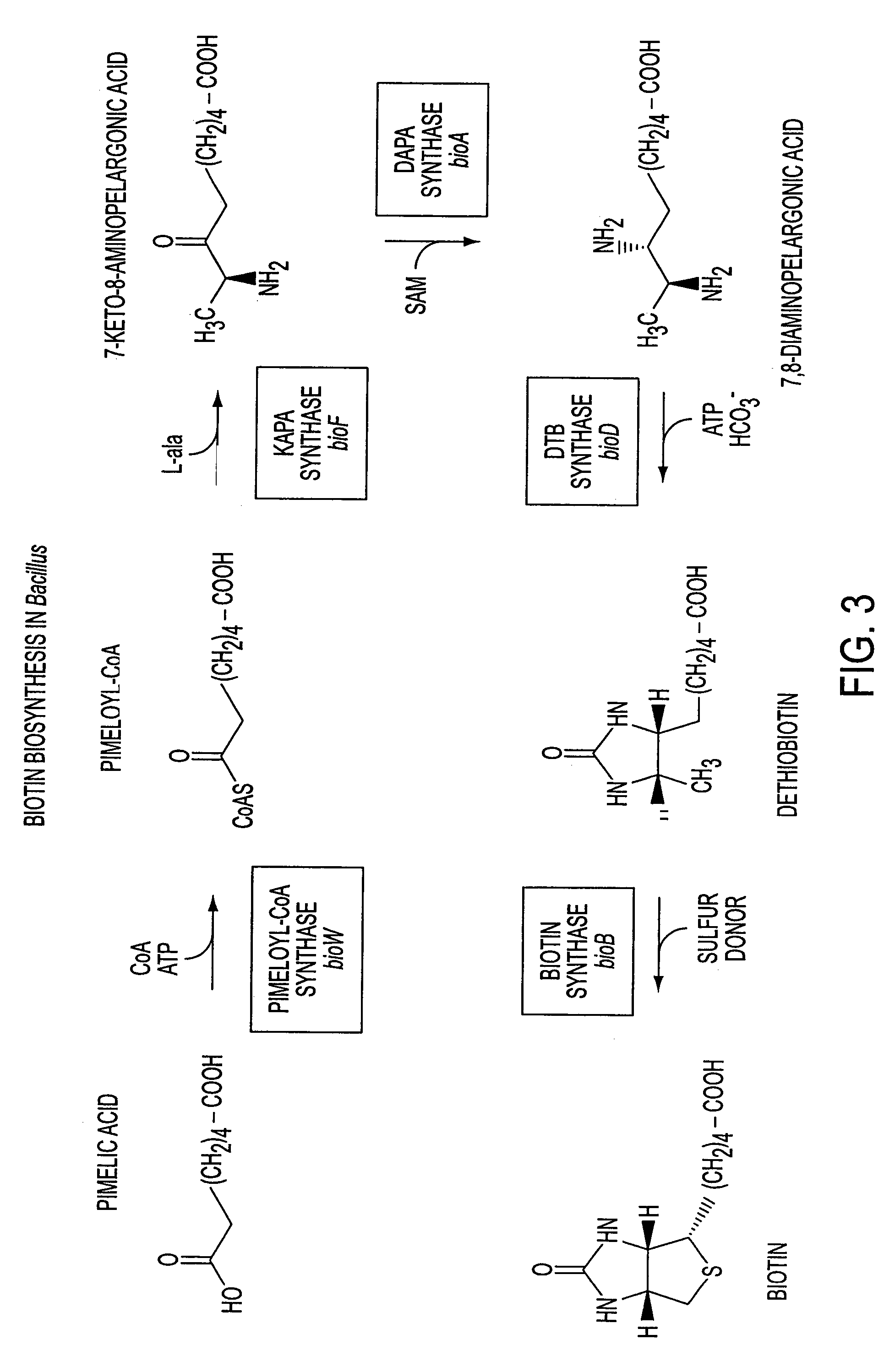Process for producing a target fermentation product
a technology of target fermentation and process, which is applied in the direction of biochemistry apparatus and processes, microorganisms, organic chemistry, etc., can solve the problems of low riboflavin productivity, inability to produce higher animals, and deregulation of the expression of the riboflavin operon
- Summary
- Abstract
- Description
- Claims
- Application Information
AI Technical Summary
Benefits of technology
Problems solved by technology
Method used
Image
Examples
example 1
Construction of Bacillus subtilis Auxotrophic Mutants
[0060]In the following examples, a biotin auxotrophy-introducing polynucleotide sequence was first constructed in E. coli. Transformation of a natural competent B. subtilis microorganism with the polynucleotide sequence resulted in a biotin auxotrophic B. subtilis mutant. A PBS1 phage lysate prepared from this mutant was then used to introduce the auxotrophy, via generalized transduction, into the production microorganism RB50 containing multiple copies of the engineered rib operon pRF69. Standard recombinant DNA techniques were used for the construction of the polynucleotide sequence and the Bacillus subtilis mutants. See, for example, Sambrook et al., Molecular Cloning A Laboratory Manual (2nd Ed.) Cold Spring Harbor Laboratory Press (1989) and Harwood and Cutting, Molecular Biology Methods For Bacillus, John Wiley and Sons (1990).
A. Construction of a Biotin Auxotroph
[0061]To construct a bioFDB deletion-insertion mutation, a 293...
example 2
Continuous Culture Fermentations
[0066]Decoupling of growth and production was achieved and resulted in the desired positive effect on the riboflavin productivity of RB50::[pRF69]Bio− as described in detail below using continuous chemostat cultures. According to standard textbooks, see e.g. Neidhardt, et al., Physiology Of The Bacterial Cell, Sinauer Associates, Inc. (1990), the growth rate of the cells within a continuous fermentation culture, which has reached steady state conditions (chemostat), equals the dilution rate at which the fermentor is operated. The concentration of the biomass within such a fermentor is correlated to the concentration of the rate limiting substrate.
[0067]Fermentations were carried out in New Brunswick bio-reactors Model Bioflow 3000 (3 l total volume) equipped with blade stirrers. Continuous chemostat cultivation was used with an inlet pump that controlled the flow rate and an overflow that controlled the liquid level in the reactor. The fermentation va...
example 3
Biomass and Riboflavin Production in Coupled and Decoupled Processes
[0074]20 μl of 40% NaOH solution was added to a 1 ml fermentation sample of example 2 immediately after collection from the fermentation reactor. The sample was incubated for 20 seconds at room temperature to dissolve riboflavin crystals within the sample. An aliquot of this suspension was diluted and neutralized with 0.1 molar potassium phosphate buffer pH 7.0. Biomass content in the suspension was measured by determination of the turbidity at 660 nm. The dilution of the sample was adjusted to achieve readings between 0.05 and 0.3 absorption units.
[0075]As a confirmation, the biomass content in the suspension was determined by weighting the dry cell mass. A 1 ml aliquot of the suspension obtained from above was transferred into pre-weighed Eppendorf vials and the bacteria were collected by centrifugation (14,000 rpm, 5 minutes). The bacteria were washed once with 1 ml deionized water and dried in vacuo at 80° C. un...
PUM
| Property | Measurement | Unit |
|---|---|---|
| Temperature | aaaaa | aaaaa |
| Fraction | aaaaa | aaaaa |
| Fraction | aaaaa | aaaaa |
Abstract
Description
Claims
Application Information
 Login to View More
Login to View More - R&D
- Intellectual Property
- Life Sciences
- Materials
- Tech Scout
- Unparalleled Data Quality
- Higher Quality Content
- 60% Fewer Hallucinations
Browse by: Latest US Patents, China's latest patents, Technical Efficacy Thesaurus, Application Domain, Technology Topic, Popular Technical Reports.
© 2025 PatSnap. All rights reserved.Legal|Privacy policy|Modern Slavery Act Transparency Statement|Sitemap|About US| Contact US: help@patsnap.com



